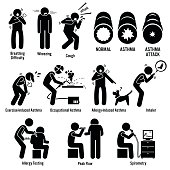Occupational Asthma

Occupational asthma
- Dental hygienists – latex
- Bakers – flour
- Roofers, insulators and painters – isocyanates (a salt or ester of isocyanic acid) – toluene (a colorless liquid hydrocarbon present in coal tar and petroleum and used as a solvent and in organic synthesis)
- Welders and metal workers – metals (nickel, platinum and chromic acid)
- Plastic manufacturers – glues and resins
- Farmers and veterinarians – animal proteins
- Carpenters – wood dust
Workplace exposure to substances that may directly irritate your lungs or lead to an immune response
- Develop sensitization* to the exposure
- Resulting inflammation of upper and lower airways
- Development of symptoms
- Exposure continues nor stopped
- Persistence of symptoms or clinical improvement
Peak Expiratory Flow Rate : Repeated PEFR are the most common method to determine if a particular antigen is the cause of occupational asthma. You will be asked to measure your PEFR readings several times per day at work and then do the same when you are at home.
Airway Inflammation-: Eosinophils (a white blood cell containing granules that are readily stained by eosin), a marker of airway inflammation, can be assessed in the sputum after working and after a period of time away from work,especially when you are at home.
Spirometry :– Similar to PEFR, but done by an experience person using a spirometer both in and out of the workplace.
Bronchoprovocation testing:- In some cases, doctors may want to have you inhale the potential offending substance to see if you develop symptoms or hyperresponsiveness (an abnormal sensitivity or over reactivity to sensory input).
Skin testing (a form of allergy testing) :– Doctors can test to see if you are already sensitized to a certain substance with skin prick testing. While a positive test does not confirm occupational asthma, atopy is a risk factor for occupational asthma. Other allergy tests can test for the presence of specific antibodies, what your body produces when exposed to a foreign substance, to specific potential offending agents.
How To Treat Occupational Asthma?
– is determined by airway irritation, obstruction, and inflammation caused by exposure to certain substances at the workplace. The exposure triggers symptoms from your immune system or through direct irritation of the airways. The symptoms to the direct irritation of the airways, begins immediately following to the exposure. When occupational exposure stimulates your immune system, symptoms usually develop after multiple exposures to a particular substance.
Occupational asthma is an occupational condition defined as: “a disease characterized by variable airflow limitation and/or airway hyper-responsiveness due to causes and conditions attributable to a particular occupational environment and not stimuli encountered outside the workplace”
Respiratory – of, relating to, or affecting respiration or the organs of respiration.
The Risk To Occupational Asthma
Some occupations are at risk for occupational asthma. A random examples of the occupations and the potential irritants include:-
Workers who are affected
Most workers in these fields will not develop asthma, but there are very high risk in patients who are atopic* (denoting a form of allergy in which a hypersensitivity reaction such as dermatitis or asthma may occur in a part of the body not in contact with the allergen), smokers and are genetically predisposed or have a family history of asthma.
Atopy – When a person is atopic*, participation in any of the above occupations increases your risk of developing occupational asthma or making pre-existing asthma more worse. If you are atopic, it is essential to have regular medical followup and follow STRICT work place PPE ( Personal Protection Equipment – Masks such as the N95 or purified air filtering units, gowns, gloves used by professionals to prevent hazardous substances)
Smoking: Smoking increases risk of developing sensitization*(the state of being sensitive -as to an antigen) to certain occupational exposures.
Genetics: Certain genetic markers(inheritance of a trait or a gene) may increase or decrease risk of occupational asthma.
Development of Occupational Asthma
Generally, occupational asthma develops in the following steps:-
Diagnosis of Occupational Asthma:-
- In each new onset (the beginning) adult asthmatic, occupational asthma should be considered. Doctors will ask about your current job exposures in addition to exposures in previous jobs. Development of cough, wheezing, and shortness of breath within months of starting a new job is a strong suggestive of occupational asthma.
- Worsening symptoms after arriving at work and improvement on weekends or during extended periods away from work are also suggestive of occupational asthma.
- Your medical professionals will also want to confirm that you have asthma and from the appropriate history, asthma can be confirmed by documenting improvement in airflow obstruction after receiving bronchodilator like Albuterol or the development of hyperresponsiveness following bronchoprovocation testing (a diagnosis of asthma,generally you will inhale a nebulized solution or preform exercise to see if you develop symptoms of asthma or airflow obstruction measured by spirometry)
From the indication of the presence of asthma, the following step is establishing the relationship to your work environment.
This can be achieved in the following ways:-
Mainly for occupational asthma is removing the worker from further exposure after a diagnosis is done and confirmed. This is especially important when the worker is sensitized to a particular substance because repeated exposures may trigger serious asthmatic reactions.
In many conditions, workers may continue with improved engineering – such as improved ventilation to reduce or eliminate the substance, or by having the worker strictly use respiratory protective equipment. Medication treatment follows the asthma action plan guidelines for asthma treatment and generally involves an inhaled steroid like Flovent or Pulmicort for occupational asthma.`
Comments
Post a Comment